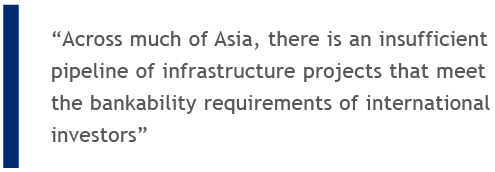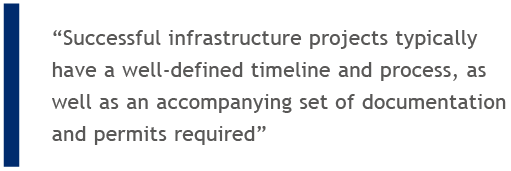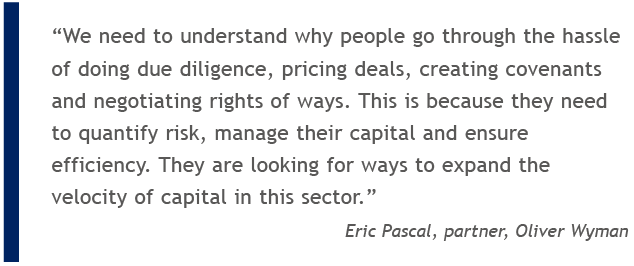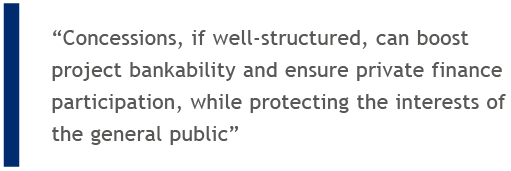Published in Asian-mena Counsel: Projects & Energy Special Report 2019
Key extracts from a report by Marsh & McLennan Companies’ Asia Pacific Risk Centre
The perceived lack of bankable projects by international investors, not the lack of available capital, is the key impediment.
 Asia has become a growth engine for the world economy, with developing Asia currently driving the majority of global growth.
Asia has become a growth engine for the world economy, with developing Asia currently driving the majority of global growth.
Given this overall boom, it is no surprise the Asian Development Bank forecast in its report Asian Development Outlook 2017: Transcending the Middle-Income Challenge that this region requires US$26 trillion of investment in infrastructure over the period 2016-2030. However, this expected demand is tempered by a reality in which there are significant uncertainties over where the money to fund this development will come from. The financing requirements are so large that a fundamental shift will be needed in how infrastructure projects are financed in a region where the public sector has historically covered over 90 percent of needs. Countries in the region that want to meet their required investment needs over the next decade and beyond will have to attract funds from global institutional investors who, to date, have generally been wary of infrastructure investment in emerging markets.
Project bankability in Asia has been a key concern for investors in infrastructure for many years. Marsh & McLennan Companies’ Asia Pacific Risk Centre estimates that between 55 percent-65 percent of projects in Asia are not bankable without support from government or multilateral development banks. Our organisation seeks to address the many challenges of project bankability in the region, by introducing a set of guidelines based on the combined expertise of Marsh & McLennan Companies’ operating companies: Oliver Wyman, Marsh, Mercer and Guy Carpenter.

DRIVING PROJECT BANKABILITY
The perceived lack of bankable projects by international investors, not the lack of available capital, is the key impediment to solving the financing gap.
Across much of Asia, there is an insufficient pipeline of infrastructure projects that meet the bankability requirements of international investors. This issue is a key driver of the infrastructure financing gap in the region and needs to be resolved for a meaningful level of international private sector investment to be channelled towards Asia.
Consistent adherence to the set of bankability guidelines outlined here coupled with the deepening of national capital markets, could markedly change the outlook for infrastructure investment in the region by creating a pipeline of bankable projects. By highlighting the key levers to support the efficient financing and construction of a project in emerging Asia, this set of guidelines is useful to investors, governments, regulators and developers alike.
The burden of responsibility to effect change sits with national governments across Asia. While many countries have begun making changes in line with international best practices, neither the volume nor the pace of change has been enough yet. Institutional investors must also change, but are well placed to do so at a faster rate than governments. They must focus on developing a deeper knowledge base of the respective host countries. Otherwise regulatory developments at the provincial levels may render a seemingly viable project at one location unbankable in another.

PROPER DOCUMENTATION AND DEAL STRUCTURE
Successful infrastructure projects typically have a well-defined timeline and process, as well as an accompanying set of documentation and permits required — where preparation and application of permits are well built into the process. Experienced financiers and contractors typically also structure the project phases and timelines in a way that minimises additional costs or risks — for example, disbursements of financing in tranches, only upon completion of certain milestones, as well as requiring explicit legal owners (usually some municipality) for construction and maintenance of ‘last mile’ infrastructure or concessions to mitigate specific project risks (such as base or availability payments to account for demand risk).
A key instrument to ensure appropriate project structure and terms would be the documentation. This process can become convoluted given the number of stakeholders involved. Additionally, inconsistent approvals and the revoking of permits in some emerging markets can deter investors, leading them to build in higher hurdle rates or longer project timelines which reduce project bankability.
Potential approval and preparation process enhancements
Some governments, as part of legislative reform, try to simplify and expedite the project approval and preparation process. In Asia, there has been significant progress particularly in Thailand and Indonesia. Both have started to streamline the entire deal preparation process, learning from past experiences where land acquisition and funding issues resulted in prolonged project delays.
APPROPRIATE COVENANTS AND FUNDING STRUCTURE
Covenants refer to specific clauses in contract agreements between two or more parties and are set in place to protect the interests of various stakeholders. The clauses, usually both financial and non-financial, typically refer to the offtake agreement as well as the lending agreement between a Special Purpose Vehicle (SPV) and the bank.
Some common financial covenants include:
• Minimum debt service coverage ratio (DSCR) requirements.
• Interest coverage ratios.
• Prepayment options.
Non-financial covenants (positive and negative) protect parties against events like construction delays, cost overruns or extraordinary instances such as the revocation of licences or permits.
The importance of covenants
Covenants are key contractual terms set down by various stakeholders to ensure their interests are met over the lifetime of the project. Financial covenants impose certain financial obligations on the SPV. For example, the borrower could be required to maintain the minimum level of DSCR as stated in the covenant to mitigate credit risk to the debt holders.
Non-financial covenants can either be positive or negative. Positive covenants, also known as affirmative covenants, are obligations the borrowers adhere to in the interests of the debt holders (for example, the obligation to keep required risk insurance in force). In contrast, negative covenants, also known as restrictive covenants, are obligations for the borrowers to refrain from performing certain actions (for example, the obligation for the SPV to not undertake any other activity except for building and operating the project).
Other key covenants are step-in rights (or embedded options) which allow for unique state-dependent control rights to protect the interest of stakeholders.
Deciding on the right covenant levels and funding structures
There have been instances of project failures due to cash flow and liquidity challenges largely driven by slow ramp-up of demand or traffic flow.
Where there are no minimum revenue guarantees or availability payouts, financing repayment should be structured to allow for flexibility in the payment amortisation schedule (or even use of deferred interest or Payment in Kind structures) while additional financial headroom should be allowed for if the private player takes on significant volume risks with the government entity also potentially undertaking a ‘first loss’ guarantee on behalf of the SPV.
In the case of sectors with single offtake agreements, the financiers should also expect the project entity to take on some form of non-payment insurance which is covered in the following section.

PRESENCE OF LEGAL AND ECONOMIC RECOURSE
The construction of large-scale projects is often met with delays, disruptions or even cancellations. As such, all stakeholders in an infrastructure deal will both put in place appropriate risk mitigants as well as further escalation (terms of settlement, litigation) procedures. In such instances, players will first seek economic settlement (out of court, through insurance or contractual claims) before escalating to forms of legal recourse.
For economic recourse, there are insurance and other risk mitigation options offered by export credit agencies (ECAs) or multilateral development banks (MDBs) that provide investors with confidence and mitigate their exposure to risks.
Private investors who do not have access to ECAs or MDBs can turn to other entities for such economic recourse. An example would include clients who have sought Marsh’s expertise for non-payment insurance for project finance lenders. Using the example of non-payment insurance, this policy not only mitigates risk, but also offers other advantages including reduced borrower credit risk, country exposure relief assistance and regulator capital relief.
A key requirement for appropriate legal recourse preferred by emerging market financiers is sovereign immunity or named centres of arbitration. The reason is the awarding authority in an infrastructure project will likely be a government authority and could consequently benefit from sovereign immunity. This immunity is a legal doctrine according to which the sovereign or state cannot commit a legal wrong and is immune from civil proceedings or criminal prosecution.
This way, the government is able to provide credible guarantee support to PPPs which would demonstrate to investors that there is a high quality of project preparation, including financial and structuring parameters. In the event that there is a guarantee call, there will be a claim assessment and the associated guarantee payments will be made to the recipient of these guarantees.
THOROUGH DUE DILIGENCE
Due diligence is a key aspect of infrastructure project deals. The complexity of project finance (in technical capability and financial structures), the magnitude of the financial investment, the scale of construction effort and the number of stakeholders involved, means that most projects have multiple teams addressing various feasibility considerations.

Prior to the launch of any infrastructure projects, feasibility studies should be conducted to assess the technical and commercial viability of the project, typically conducted by a mix of engineering, legal, as well as finance teams. This is important given the complexity and magnitude of the financial and technical outlay involved. In developed markets, third-party companies with specialised expertise are typically contracted by the project entity to provide the due diligence required.
These services can typically be broken down into a number of categories:
• Environmental impact and technical assessments.
• Financial assessments — which could involve financing structures, deal structures, sufficiency of risk mitigants (insurance, hedging contracts, etc.).
• Commercial aspects such as demand or revenue forecasting, ROI optimisation, the political and regulatory outlook, competitor scans and pricing levels.
• Legal clauses, for example, concessions, availability of financing, offtake agreements and risk mitigants.
Projects in emerging markets are increasingly encouraged along this developmental path, in a bid to improve both the project success rate as well as project bankability.
WELL-STRUCTURED CONCESSION RIGHTS
A concession granted to the winning project bidder gives the SPV long-term rights to use public assets (land, operating licences, etc) in return for the SPV being contractually responsible for the full delivery of services. Services can include the operation and maintenance of the assets as well as for financing and managing the required investment.
Concessions for usage or operation of assets are also typically coupled with offtake mechanisms. In this case, the concessionaire obtains most of its revenues directly from its users through tariff levels established by the authority in the offtake contract. These can include payment schedules, changes in payment schedules over time as well as events to trigger a review of the payment schedule.
Relying on the ‘invisible hand of the free market’, it is then the prerogative of the concessionaire to achieve improved levels of efficiency and effectiveness since any gains in efficiency translate into increased profits and returns to the concessionaire (although regulators may set additional key requirements such as maintenance and renewal or replacement of assets).
Additional concessions may be given (or adjusted) where the deal economics may be potentially challenging, for example if the aggregate amount of tariffs collected by the concessionaire is not sufficient to cover the cost of operation of the assets (or even maintenance or further investment). In capital-intensive projects where there is a high initial capital outlay, for instance, there has to be some degree of revenue recovery or minimum guarantees (such as availability payments or exemption of operating licence fees) to ensure the project company can sufficiently meet interest and debt repayments.
Using concession rights effectively
Concessions, if well-structured, can boost project bankability and ensure private finance participation, while protecting the interests of the general public. For example, non-compete concessions or assurances are typically demanded for volume-dependent infrastructure such as toll roads. These can include the prohibition of new entrants into the market, which could adversely affect project economics.
ROBUST RIGHTS TO PAYMENT
The right to payment is the mechanism governments use to determine payments to investors. It is used to provide an incentive for the operator to meet the availability and performance standards set out by the public authority as well as match payments to the outcomes and outputs that the authority wishes to deliver.
Developing robust payment mechanisms
The authority should structure the payment mechanism in a way that is not only realistic and fair in supporting the long-term partnership, but also objective, transparent and easy to operate. To make it more robust, the public agency should seek feedback from the operators prior to developing the payment mechanism. The payment mechanism should not only incentivise the operators to deliver the service at the required standards but also include penalties to deter the operators from providing sub-standard performance or none at all. Depending on the nature of the projects, the payments may vary with these elements:
• Availability of service.
• Performance quality of service.
• The usage of service.
Ensuring appropriate risk transfer
Defining the legal payees is important for any capital-intensive project where revenues are required to cover capital outlay as well as operations and maintenance spending. For utilities, offtake payments are common, with further guarantees required if the payor is deemed to have a high risk of delayed or missed payments. In addition, there are also increasingly more well-structured payments rights — fixed or variable charges and payment pegged to raw material cost. These payment rights may include the renegotiation of tariffs at stipulated time periods. For non-utilities such as rail and toll roads, it is even more crucial to clearly define payors and sources of income as this is crucial for understanding project economics and therefore attracting investors.

CONCLUSION
It is clear that the expected demand for infrastructure in Asia far exceeds the public sector’s ability to finance them. Private sector investment into infrastructure is as critical an imperative now as it has ever been. If no action is taken, economic growth in the region will stall and the social implications will be profound.
Governments in the region must take responsibility to change their local legal, financial and regulatory environments to support fair and transparent infrastructure development. It is often the countries with the largest need for foreign investment in infrastructure which have the most work to do to create such an environment. Public-private partnerships will play a key role in changing the infrastructure landscape in the region. Where these are structured effectively and with appropriate risk allocation, the value will come not just from the supply of private sector capital, but equally from broader private sector expertise in deal financing and efficiency gains from the improved management of operational assets.
Ultimately, projects need to be seen as bankable and also provide competitive returns on a risk-adjusted basis when compared to global alternatives. The guarantees offered by governments and multilateral development banks will continue to be important in this regard, as will the use of broader risk mitigation and transfer mechanisms.
Despite the known challenges, it is an exciting time for the infrastructure industry in Asia.
The future demand for power in the region is unquestionable. What remains to be seen is how the concept of the Energy Trilemma (achieving a balance between energy security, cost of supply and environmental impact) affects the investment and technology decisions taken by governments in the region.
China’s Belt and Road Initiative has a long way to go before it can be considered a success, but the scheme undoubtedly has great potential. However, questions remain as much around the geopolitical implications of the investments as financing and bankability concerns. The initiative is therefore ripe for further cross stakeholder collaboration and research.
Increased regional cooperation will not just be led by China. Discussions continue around a potential Asean power grid, while India, Nepal, Bangladesh, Bhutan, Myanmar and Thailand are progressing with a scheme to link the countries through a highway network. The outcome of the Regional Comprehensive Economic Partnership (RCEP) trade agreement impacts infrastructure development in the region as well.
While governments in Asia must take the lead in creating a more transparent and conducive environment for infrastructure investment, other stakeholders should not wait passively in the background. Those who start building their local knowledge, capabilities and partnerships now will be best placed to benefit from future changes that this report has outlined.
__________________________________
Marsh is one of the Marsh & McLennan Companies (NYSE: MMC), together with Guy Carpenter, Mercer and Oliver Wyman.
Disclaimer: This document is not intended to be taken as advice regarding any individual situation and should not be relied upon as such. The information contained herein is based on sources we believe reliable, but we make no representation or warranty as to its accuracy. We shall have no obligation to update this publication and shall have no liability to you or any other party arising out of this publication or any matter contained herein. Any statements concerning actuarial, tax, accounting or legal matters are based solely on our experience as an insurance broker and are not to be relied upon as actuarial, tax, accounting or legal advice, for which you should consult your own professional advisors. We make no representation or warranty concerning the application of policy wording or the financial condition or solvency of insurers or re- insurers. Although we may provide advice and recommendations, all decisions regarding the amount, type or terms of coverage are the sole responsibility of the insurance purchaser, who must decide on the specific coverage that is appropriate to its particular circumstances and financial position. Insurance coverage is subject to the terms, conditions and exclusions of the applicable individual policies. Policy terms, conditions, limits and exclusions (if any) are subject to individual underwriting review and are subject to change.
To obtain professional advice from Marsh for management of infrastructure projects, please don’t hesitate to contact Sue Yen Leow.
![]()
T: (852) 2301 7323
 Click Here to read the full issue of Asian-mena Couddnsel: Projects & Energy Special Report 2019.
Click Here to read the full issue of Asian-mena Couddnsel: Projects & Energy Special Report 2019.




















